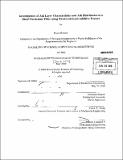Investigations of ash layer characteristics and ash distribution in a diesel particulate filter using novel lubricant additive tracers
Author(s)
Morrow, Ryan (Ryan Michael)
DownloadFull printable version (9.826Mb)
Other Contributors
Massachusetts Institute of Technology. Dept. of Mechanical Engineering.
Advisor
Alexander Sappok.
Terms of use
Metadata
Show full item recordAbstract
Diesel particulate filters (DPF) are currently widely used in various applications as a means of collecting particulate matter in order to meet increasingly stringent particle emissions regulations. Over time, the DPF slowly accumulates incombustible material or ash, mostly from the metallic additives present in the engine lubricant. This build up of accumulated ash leads to an increase in flow restriction and therefore an increase in pressure drop along the DPF. The increased pressure drop negatively impacts engine performance and fuel economy, and it also requires eventual filter removal for ash cleaning. While the major effects of ash accumulation on DPF performance are known, the fundamental underlying mechanisms are not. This work is focused on understanding key mechanisms, such as the soot deposition and the ash formation, accumulation, and distribution processes, which play a major role in determining the magnitude of the ash effect on DPF pressure drop. More specifically, it explores the location of ash deposit accumulation inside the DPF channels, whether in a layer along the filter walls or packed in a plug at the rear of the channels, which is one of the key factors controlling DPF pressure drop. A specialized experiment was set up by running three different lubricants, each with its own unique additive tracer, sequentially through a diesel burner system. Scanning electron microscopy (SEM) was used to analyze the evolution of the ash deposits in the DPF samples in order to explain the specific mechanisms and processes controlling ash properties and their effect on DPF pressure drop. The experimental results were compared and correlated with previous DPF test data and theoretical models, providing additional insight to optimize diesel particulate filter performance. The results are useful in optimizing the design of the engine, aftertreatment, and lubricant systems for future diesel engines, balancing the requirements of additives for adequate engine protection with the requirements for robust after treatment systems.
Description
Thesis (S.B.)--Massachusetts Institute of Technology, Dept. of Mechanical Engineering, 2010. Cataloged from PDF version of thesis. Includes bibliographical references (p. 59, 62).
Date issued
2010Department
Massachusetts Institute of Technology. Department of Mechanical EngineeringPublisher
Massachusetts Institute of Technology
Keywords
Mechanical Engineering.